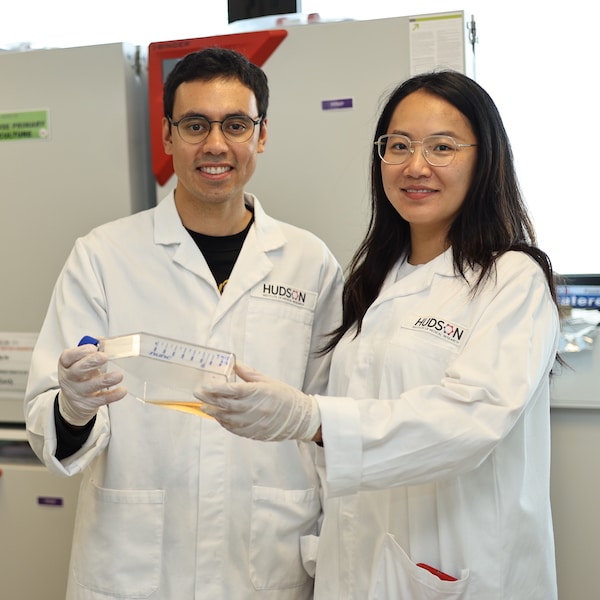
Curing childhood cancer: all roads lead to Melbourne
The original news article can be found on Hudson’s website HERE
A single laboratory in south-east Melbourne is now the global hub for medical researchers looking to cure childhood cancer.
Located at Hudson Institute of Medical Research, the laboratory contains the Childhood Cancer Model Atlas (CCMA), the world’s largest collection of high-risk paediatric cancer cell lines, providing a unique, open-source facility to cancer researchers worldwide.
The story of the CCMA features in the latest edition of prestigious scientific journal, Cancer Cell.
Fellow researcher Dr Sun had the job of compiling, collating and condensing huge amounts of data, as the team performed hundreds of tests on each tumour type: “Children’s cancers make up only about one per cent of all diagnosed cancers, so the pharmaceutical industry tends not to invest in finding new treatments,” she said.
Co-leader of the Victorian Paediatric Cancer Consortium (VPCC) Precision Medicine Program, Professor Ron Firestein, says there is a desperate need to find new treatments and cures for the cancers that affect children.
“Paediatric cancers are quite unique from adult cancers, so we don’t necessarily expect the same drug that works in adult cancers to work in children,” said Dr Paul Daniel, who along with Dr Claire Sun was lead author on this research paper.
“The CCMA is a collection of over 300 childhood cancer cell lines which offers us an opportunity to identify new therapies and biomarkers of response for paediatric cancers of greatest unmet medical need,” Dr Daniel said.
Fellow researcher Dr Sun had the job of compiling, collating and condensing huge amounts of data, as the team performed hundreds of tests on each tumour type: “Children’s cancers make up only about one per cent of all diagnosed cancers, so the pharmaceutical industry tends not to invest in finding new treatments,” she said.
Professor David Eisenstat, Head of the Children’s Cancer Centre at Melbourne’s Royal Children’s Hospital and Group Leader, Neuro-Oncology at the Murdoch Children’s Research Institute, said: “Drs Sun, Daniel and Professor Firestein have addressed the urgent need to develop a childhood cancer cell line resource to identify specific cancer vulnerabilities towards improving targeted therapies for paediatric solid and central nervous system tumours. Their work also provides important insights into new targets of clinical relevance for paediatric focused cancer drug development.”
Assistant Professor of Paediatrics at Harvard Medical School, Dr Mimi Bandopadhayay agrees: “Understanding the vulnerabilities of paediatric tumours is essential to help identify new therapeutic approaches. This work is a tour de force that includes the largest collection of brain tumour models, generating a resource that will be invaluable to researchers across the world.”
The CCMA is the outcome of seven years of support and more than $7 million in funding from the Children’s Cancer Foundation. It was developed through active collaborations with 34 cancer research institutes, including Stanford University (USA), the University of California (San Francisco, USA), The Hospital for Sick Children (Canada), Johns Hopkins University (USA), McGill University (Canada), the Institute of Cancer Research (UK), and Hopp Children’s Cancer Center Heidelberg (Germany).
The CCMA also benefited from the support of the Australian Government’s Medical Research Future Fund and the Robert Connor Dawes Foundation.
Robert Connor Dawes Founder & CEO, Liz Dawes OAM said she is proud to support this great work, “advancing better understanding and ultimately treatment for young people with brain cancer.”